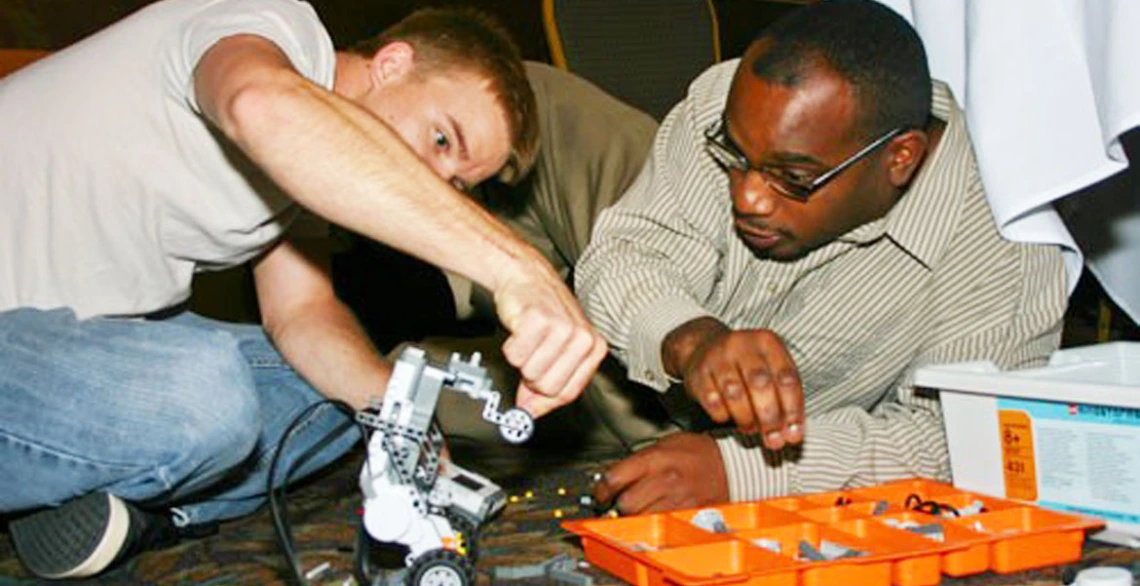Teachers Become Students as They Prepare to Teach High School Engineering
Arizona teachers become students at a workshop that is part of a program to increase the number of engineering graduates.

Graduate student John-Jozef ("J.J.") Proczka, left, and Mountain View High School teacher Robert Kennerly get to grips with a Lego robot they will use to teach engineering principles to students enrolled in ENGR 102 HS at Mountain View High School.
Sixteen teachers from 17 high schools in Tucson, Phoenix and Yuma attended the 2-week workshop July 12-23 at the Tucson Omni National Resort. The objective was to prepare teachers for the upcoming semester, when they will start teaching the Engineering 102 High School curriculum. The program, known as ENGR 102 HS, is only in its third year and already includes 17 schools.
Advisors and faculty from the College of Engineering were on hand while teachers attended practical sessions on building solar ovens, Lego robots, and model canoes and catapults, as well as theoretical sessions on engineering design and systems engineering. The teachers will now return to their classrooms and pass on their knowledge to students who want to earn credit hours toward an engineering degree.
The Tucson Unified School District, in partnership with the UA College of Engineering, won a two-year grant in 2009 from Science Foundation Arizona to implement a program aimed at boosting the number of engineering graduates.
The class carries UA credit and has three main goals: To introduce engineering to math- and science-savvy students who may not have considered it as a career; to give students who really want to be engineers a head start on college; and to help students find out if an engineering career is for them.
A pioneer of the program is Jim Clark of Hamilton High School in Chandler, Ariz. Hamilton High was the first school to adopt the program; Clark is an engineer who went into teaching.
"I have two degrees in engineering and I was a practicing electrical engineer at Motorola," Clark said. "When I came to teaching, part of my goal was to get more kids interested in engineering."
Clark was motivated in part by what educators and employers see as alarming statistics from abroad. "You often see in the media that countries like China and India are graduating orders of magnitude more engineers than we are," he said. "I saw that a couple of years ago Mexico graduated more engineers than the U.S."
Clark's concern is that the long-term effects of reduced numbers of engineers will be detrimental to our everyday lives. "We have a problem in our country because, if we're not actually designing and building anything any more, we are going to lose high paying jobs and our world leadership in terms of science and technology," warned Clark. "In the end our standard of living could dramatically decrease if we become a pure service economy."
The program was a success right from the beginning at Hamilton High. "In the first year, every single one of the 21 kids in the class went into an engineering major at college," Clark said. "Pretty much every student who goes through my course ends up trying engineering at university. For me, the program has worked tremendously well."
Mark Calhoun, who teaches physics and engineering, has seen similar success at Sabino High School in Tucson, where he has taught the ENGR 102 curriculum for 2 years. Sabino High recently won a regional innovative program award from the Association for Career and Technical Education. "Part of the reason for that award was because of 102 and the UA credit," said Calhoun.
From his last graduating class of 25 students, 23 went into engineering majors, 19 of them at UA. Like many educators, Calhoun believes even more high school students could be inspired to go into engineering if they were exposed earlier to the field. "Students on this program are mostly seniors who already know they want to do engineering," Calhoun said. "Kids need to be steered towards engineering much sooner. Even before high school -- middle school would be ideal."
Early involvement is essential, Calhoun said, because students can get behind quickly if they are not inspired. "Kids need to understand that math and physics are involved," he said. "Not doing your homework in middle school is not the way to become an engineer."
High school students certainly benefit from this program, but what about the teachers? Sarah Streb, at teacher at Salpointe Catholic High School in Tucson, is new to the program and new to engineering. "I'm really excited about it," said Streb, who sees the inherent value of the program as an opportunity for professional development. "And when my students found out about it, they were super excited. The class is almost full."
Streb's students can't wait for the program to begin, she said, and they keep asking her what they'll be doing in class. "I didn't know, so I'm here to find out," she said. "I've heard a lot of really good ideas this week about what to do, where to start. And met a lot of people to contact if I need help."
Streb's message to her students is that engineers help people. She is aware that there are a lot of stereotypes associated with engineering, but she tells her students that "engineering involves some pretty cool stuff." Her hope is that her students will realize that engineering is "not all about sitting at a computer doing math."
Streb is also aware of the power of peer networking among students. "Hopefully, they'll get the word out and start recruiting for the class," she said. The word-of-mouth effect is powerful among high school students, notes Streb. "I'm hoping to have two classes next year," she said.

